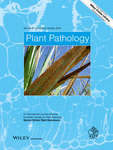Ver ítem
- xmlui.general.dspace_homeCentros e Institutos de InvestigaciónCIAP. Centro de Investigaciones AgropecuariasInstituto de Patología VegetalArtículos científicosxmlui.ArtifactBrowser.ItemViewer.trail
- Inicio
- Centros e Institutos de Investigación
- CIAP. Centro de Investigaciones Agropecuarias
- Instituto de Patología Vegetal
- Artículos científicos
- Ver ítem
Distribution and phylodynamics of papaya ringspot virus on Carica papaya in Cuba
Resumen
Orchard and garden papaya crops grown in 47 Cuban municipalities were surveyed from 2008 to 2013, revealing the widespread distribution of papaya ringspot virus (PRSV) in Cuba. Phylodynamic analyses performed with the partial coat protein gene of all Cuban PRSV‐P isolates (34 sequences) and 107 sequences of isolates from the American continent and the Caribbean islands showed a most recent common ancestor in 1942 (95% highest posterior density, HPD 95% =
[ver mas...]
Orchard and garden papaya crops grown in 47 Cuban municipalities were surveyed from 2008 to 2013, revealing the widespread distribution of papaya ringspot virus (PRSV) in Cuba. Phylodynamic analyses performed with the partial coat protein gene of all Cuban PRSV‐P isolates (34 sequences) and 107 sequences of isolates from the American continent and the Caribbean islands showed a most recent common ancestor in 1942 (95% highest posterior density, HPD 95% = 1911–1967). The substitution rate was estimated to be 7.7 × 10−4 substitutions per site per year (HPD 95% = 4.6 × 10−4 to 1.1 × 10−3), which is equivalent to those detected in other RNA viruses. Demographic reconstruction of PRSV showed that viral diversity increased in the 1985–1990 period, which coincides with the implementation of extensive production practices. Moreover in Cuba, viral dispersion occurred from Mexico and other unknown ancestral locations. The spatiotemporal diffusion analysis proposed Mexico as an ancestral area for the origin of diversification in the American continent and suggests new dispersion events between American and Caribbean isolates. The observed widespread distribution, clear geographic grouping of Cuban isolates, virus growth and genetic diversity provide strong evidence of the PRSV dispersion patterns, which has implications for the control strategies of PRSV.
[Cerrar]

Autor
Cabrera Mederos, Dariel;
Giolitti, Fabian;
Torres, Carolina;
Portal, Orelvis;
Fuente
Plant pathology. (08 September 2018)
Fecha
2018-09
Editorial
Wiley; British Society for Plant Pathology
ISSN
1365-3059
Formato
pdf
Tipo de documento
artículo
Palabras Claves
Derechos de acceso
Restringido
 Excepto donde se diga explicitamente, este item se publica bajo la siguiente descripción: Creative Commons Attribution-NonCommercial-ShareAlike 2.5 Unported (CC BY-NC-SA 2.5)
Excepto donde se diga explicitamente, este item se publica bajo la siguiente descripción: Creative Commons Attribution-NonCommercial-ShareAlike 2.5 Unported (CC BY-NC-SA 2.5)
Metadatos
Mostrar el registro completo del ítemÍtems relacionados
Mostrando ítems relacionados por Título, autor o materia.
-
Aggressiveness of Cuban Papaya ringspot virus Isolates on Carica papaya L. cv. Maradol Roja under Greenhouse Conditions
Cabrera Mederos, Dariel; Cruz, Maylin; Nome Docampo, Claudia; Giolitti, Fabian; Portal, Orelvis (SciTechnol, 2017-04-16)Carica papaya is a major fruit crop in tropical and subtropical regions; however, its production has several constraints. Papaya ringspot virus (PRSV) is the most important pathogen affecting papaya plantations. Symptoms ... -
First report of Papaya ringspot virus infecting Carica papaya in Argentina
Cabrera Mederos, Dariel; Dal Zotto, Angelica; Galdeano, E.; Portal, O.; Giolitti, Fabian (Dipartimento di Scienze del Suolo, della Pianta e degli Alimenti, Università di Bari, 2016-06-20)Papaya plants (Carica papaya L.) with severe leaf mosaic and deformation symptoms were observed and collected in the Formosa, Corrientes and Misiones provinces of northern Argentina. These symptoms were similar to those ... -
Relative incidence of cucurbit viruses and relationship with bio-meteorological variables
Pozzi, Elizabeth Alicia; Bruno, Cecilia Inés; Luciani, Cecilia; Celli, Marcos Giovani; Conci, Vilma Cecilia; Perotto, Maria Cecilia (Springer, 2020-02)Environmental heterogeneity can shape the plant-virus relationship, furthering the appearance of new diseases in crops, or altering disease incidence and severity. In this work, we studied the virus association with ...

